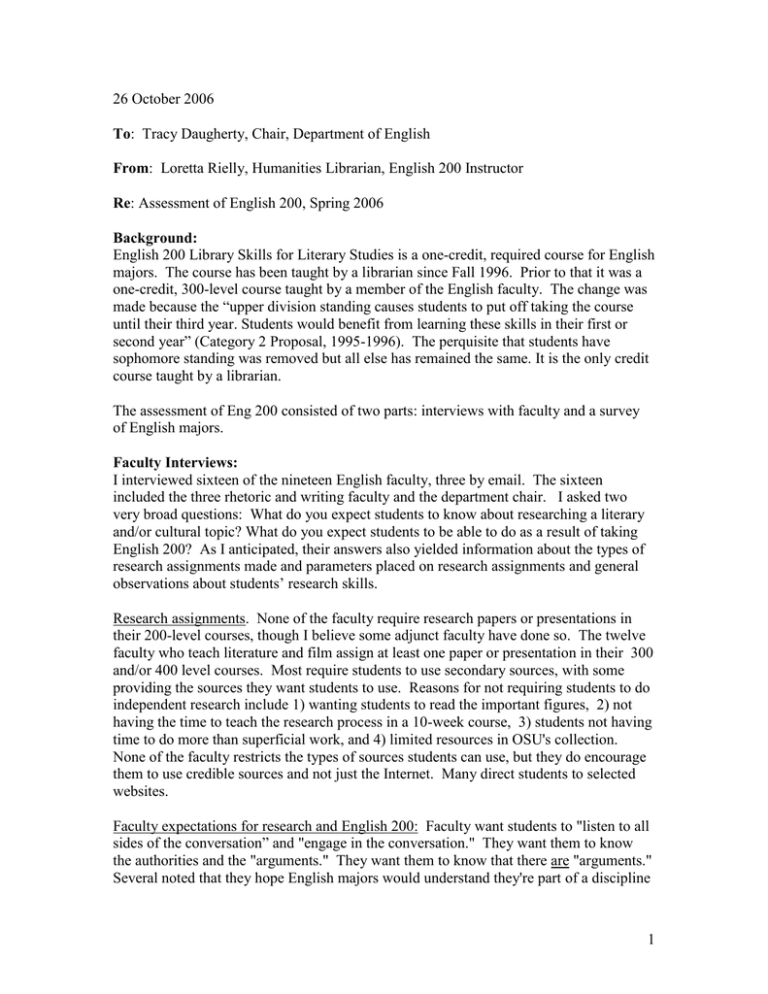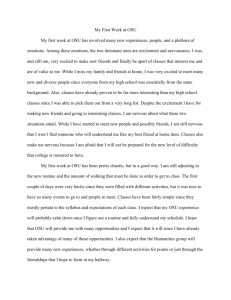26 October 2006 To
advertisement

26 October 2006 To: Tracy Daugherty, Chair, Department of English From: Loretta Rielly, Humanities Librarian, English 200 Instructor Re: Assessment of English 200, Spring 2006 Background: English 200 Library Skills for Literary Studies is a one-credit, required course for English majors. The course has been taught by a librarian since Fall 1996. Prior to that it was a one-credit, 300-level course taught by a member of the English faculty. The change was made because the “upper division standing causes students to put off taking the course until their third year. Students would benefit from learning these skills in their first or second year” (Category 2 Proposal, 1995-1996). The perquisite that students have sophomore standing was removed but all else has remained the same. It is the only credit course taught by a librarian. The assessment of Eng 200 consisted of two parts: interviews with faculty and a survey of English majors. Faculty Interviews: I interviewed sixteen of the nineteen English faculty, three by email. The sixteen included the three rhetoric and writing faculty and the department chair. I asked two very broad questions: What do you expect students to know about researching a literary and/or cultural topic? What do you expect students to be able to do as a result of taking English 200? As I anticipated, their answers also yielded information about the types of research assignments made and parameters placed on research assignments and general observations about students’ research skills. Research assignments. None of the faculty require research papers or presentations in their 200-level courses, though I believe some adjunct faculty have done so. The twelve faculty who teach literature and film assign at least one paper or presentation in their 300 and/or 400 level courses. Most require students to use secondary sources, with some providing the sources they want students to use. Reasons for not requiring students to do independent research include 1) wanting students to read the important figures, 2) not having the time to teach the research process in a 10-week course, 3) students not having time to do more than superficial work, and 4) limited resources in OSU's collection. None of the faculty restricts the types of sources students can use, but they do encourage them to use credible sources and not just the Internet. Many direct students to selected websites. Faculty expectations for research and English 200: Faculty want students to "listen to all sides of the conversation” and "engage in the conversation." They want them to know the authorities and the "arguments." They want them to know that there are "arguments." Several noted that they hope English majors would understand they're part of a discipline 1 with a history, and that when they write, they're participants in the ongoing conversations of their discipline. Most faculty voiced concerns about students simply stringing quotations together and not moving move beyond "I agree" / "I disagree" statements. Faculty expect student to know about and use a wide range of sources. Several mentioned they specifically want them to "know" the physical collection, the print journals and the books in the stacks. They want them to select good sources and recognize bias. One faculty wants his students to be able to identify refereed journals; another wants them to be able to differentiate between reviews and literary criticism. Nearly all faculty expect students to know MLA citation format, or at least the principles of citation. In terms of using specific research databases, MLA and Project Muse were cited most frequently. One faculty member wonders why students don't use MLA, while another questions students' using it because of the complexity of the sources cited. Faculty expect students to use the OSU Library Catalog and Summit Catalog; one faculty member recommends OCLC's WorldCat for primary sources. Student Survey: The survey was distributed to all English majors, and 71 responded. Four students skipped most of the questions, leaving 67 usable responses. Of these, 57 (85.1%) had taken English 200: 7 freshman, thirteen sophomores, fifteen juniors, and 20 seniors. This report primarily reflects those results. The survey consisted of three parts: background information, research practices in general, and impact of English 200 on subsequent studies. I've attached copies of the results for all students, students who have taken English 200, and students who have not taken it. This narrative will highlight the findings I find most significant and/or relevant in respect to English 200, with the caveat that I'm working with a small sample and make no attempt to indicate whether results are statistically significant or not. As with most surveys, this is a snapshot in time. Formats, research tools, and research techniques In English 200, I teach concepts, processes and tool, emphasizing the OSU and Summit Catalogs, research databases in the humanities, and using information found in works cited pages and bibliographies to find additional information. In the survey, I asked a number of questions about sources and techniques students use when researching a literary topic. The results are not terribly surprising. All students, including those who have taken English 200, prefer online sources, whether subscription journals or websites on the Internet. If it's not available online, they want to find it locally. Over half the students who have taken English 200 always or frequently use the OSU catalog. Few always or frequently use Summit (9 students, 16%) or InterLibrary Loan (4 students, 7%) to request items not available here despite the limitations of OSU’s collection. Over half the students who have taken English 200 always or frequently use MLA Bibliography (30, 53%). Only 18% (10) report always or frequently using Project Muse. Although the library did not subscribe to Project Muse's humanities and social sciences collections until January 2004, most students appear to have taken English 200 in the last 2 two years and I would have expected this number to be higher. Probably the most startling data in the survey, especially given the emphasis on following the conversations in a discipline, is the very low use of bibliographies found in books and articles: only 20% (11 students) always or frequently use them while 47% (26) seldom or never do. They do report considering the authority of the author when selecting sources, however (34 students, 59%: always or frequently). Students’ assessment of effectiveness of English 200 Over half the students (38 students, 67%) agree or strongly agree with the statement: “English 200 provided the skills I needed to complete research assignments in my English literature classes.” Most comment that they learned new options for doing research. The remaining responses were neutral (15 students, 26%), disagree (3 students, 5%), and strongly disagree (1 student, 1%). The most frequent comment for respondents in all three of these latter groups is "I already knew how to use the library/do research." Two students (1 neutral, 1 disagree) noted that by the time they needed to do research for a class they had "forgotten" what they'd learned. Asked what would improve English 200, most responses are mixed and not unexpected: it's good the way it is, too much busy work, too easy, too hard, make it online, don't require it, and so forth. Still, there were many thoughtful and constructive comments and suggestions. Several students noted that it should be more than 1 credit or meet more frequently given the amount of work. One student suggests being able to challenge the class. A number of responses to this question and one that asked what they did not learn echo the faculty’s linking of researching with writing: students suggest requiring a paper or outline to bring the research to a conclusion, making it part of another class, or having the major assignment parallel an assignment in an English class. One writes, “The entire process is important, from choosing an appropriate topic, to researching it, to the proper form of the paper itself (note taking, citations, bibliography, etc.).” Observations 1. The link between English 200 and the English curriculum is fragile. Even when students are required to complete a “Research Guide,” it feels artificial to many of them, and frankly, to me. Although I have given students the option of doing an annotated bibliography for a research paper they’re writing in another course, none has taken advantage of it because they either don’t have a research assignment or the timing is wrong. 2. For both faculty and students, research culminates with writing. When I asked them about their expectations for students’ research, all faculty talked about writing and “engaging” with sources. Without a real product, the work seems left undone. 3. If students are not expected to do independent research, they will not have opportunities to apply what’s taught in English 200. Also, if they are not held accountable for the quality of the sources they use, they’ll use what’s most accessible and familiar. A couple of years ago, a student accused me of being “biased” about the 3 Internet and library sources. Well, I am, but I also understand his perspective: his experience had been that Internet sources are sufficient. 4. Most students who take English 200 have never had to write an English paper using secondary sources, and some wonder why they’d want to. Last year a student commented about using a bibliography: “It’s ok if you wanted to read what someone else says.” 4. Students who take English 200 are novice library users. Each term, I ask students to complete a library assessment the first week in order to gauge their experience. The 155 responses are from freshmen (19%), sophomores (30%), juniors (26%), seniors (24%) and 2 post-baccalaureate students. Some of the results are startling, even accounting for those students who don’t understand the terms used. 31% (48) have never looked for a book in the library. 76% (117) have never used a print journal 52% (81) have never used the OSU catalog 69% (107) have never used Academic Search Premiere 6. English 200 has been a skills course for the department but it has the potential to prepare students for their future careers. Over 60% of all students who took the survey want to go to graduate school and 30% plan to teach. Recommendation English 200 should be more closely related to the English curriculum, perhaps as a “lab” in an existing course or courses, or in an expanded “researching and writing” course. If it’s to remain a stand-alone course, the number of credit hours should be increased. Students’ limited experience and time limitations have necessitated devoting a good deal of time to basic processes and use of the tools and less time on the concepts and critical decisions students must make during the research process. Since students will study and teach in a very different information environment than today’s, learning the concepts is essential. The tools will change. cc: Anita Helle, Associate Chair, Department of English Ruth Vondracek, Head of Research, Consulting and Innovative Services, OSU Libraries John Pollitz, Associate University Librarian for Public Services and Innovative Technology, OSU Libraries 4
